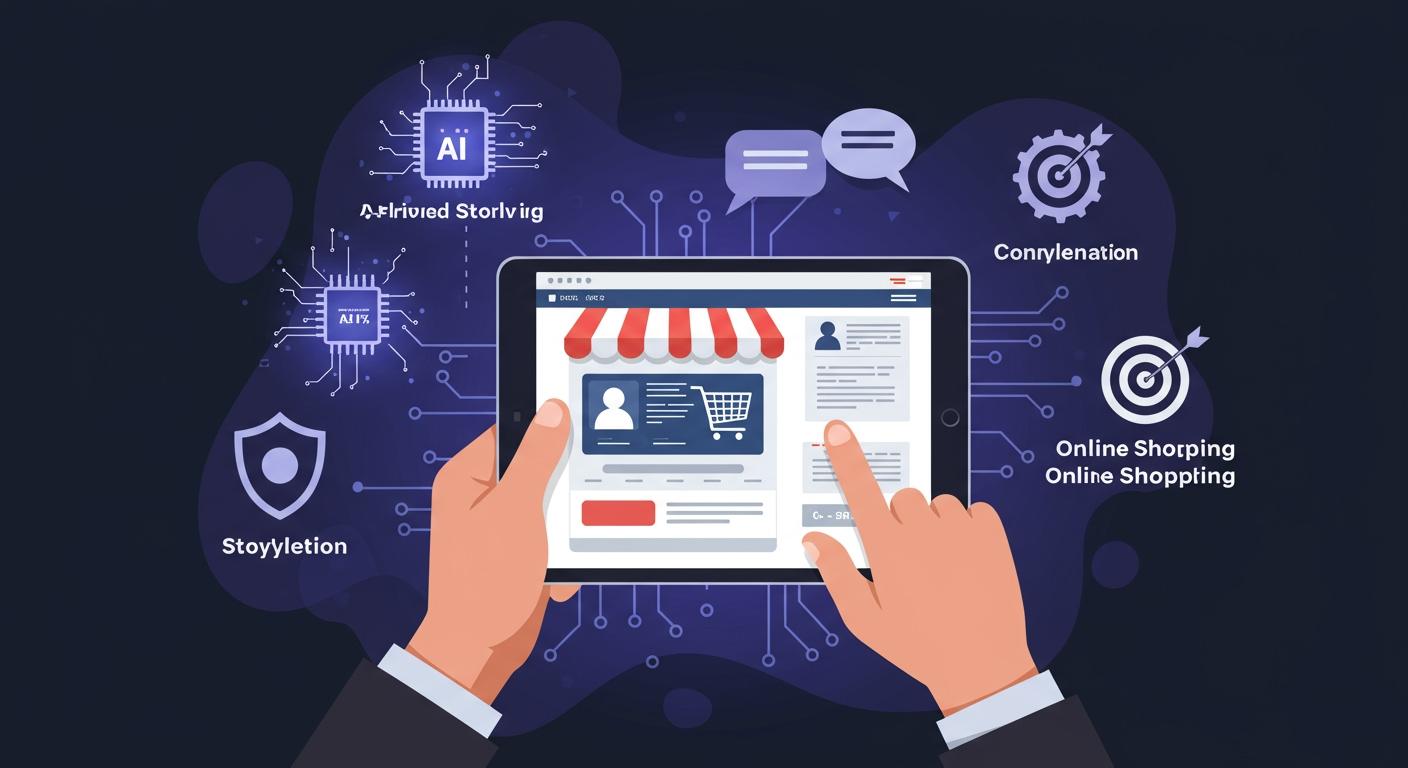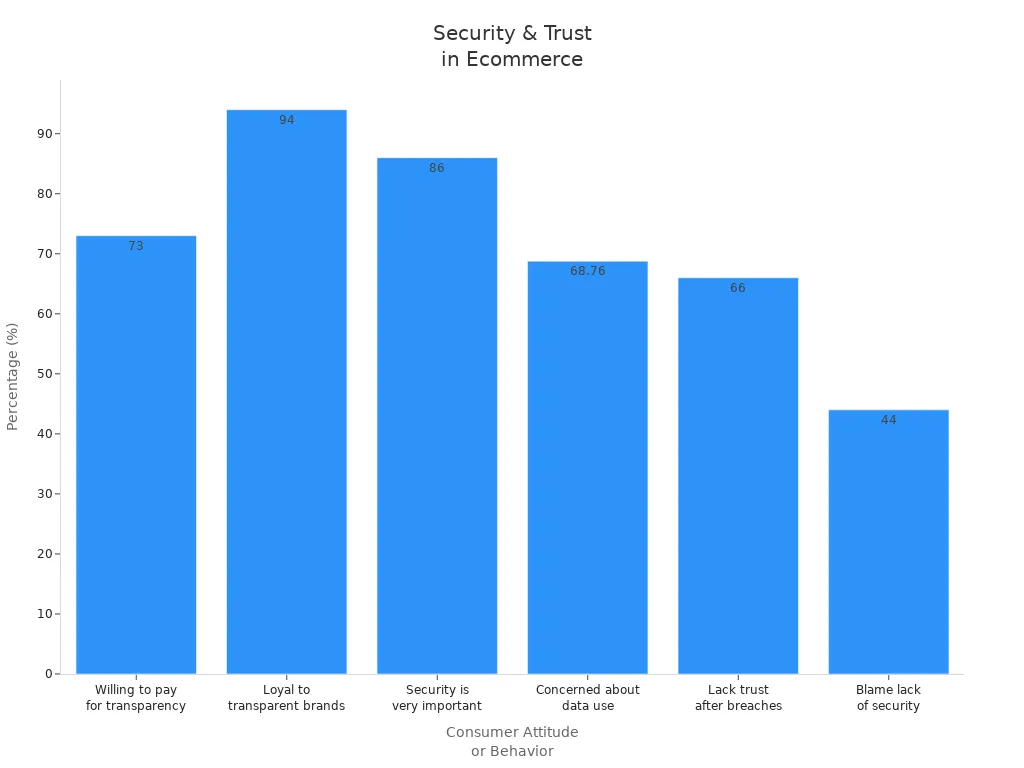The Future of Ecommerce Branding: AI Storytelling for Trust and Conversion

AI storytelling now shapes how you trust and connect with brands online. Did you know that AI can boost conversion rates by up to 25%? You see this in action with brands like L’Oréal and Nike. L’Oréal lets you try on makeup virtually, while Nike uses AI to recommend the perfect shoe size. These experiences make shopping easier and more personal. AI brings new opportunities for Ecommerce Branding, but you also need to balance technology with transparency and a human touch.
Key Takeaways
AI storytelling can help more people buy things. It can make shopping feel special and quick.
Brands use AI to make ads that fit each person. They look at how people shop. This makes shopping better for everyone.
Trust is very important in online shopping. AI helps by sending honest messages that matter to people.
Good pictures and reviews from real users help people trust brands. These things make people want to buy more.
Brands need to keep data safe and be open about it. This helps people trust them and feel safe when shopping.
AI and human ideas together make stories feel real. This helps brands connect with people in a special way.
Brands should check their results often. This helps them see if their AI plans work and change things if needed.
A strong team with many skills is needed for good AI stories. This mixes tech and people for the best results.
Ecommerce Branding Evolution

From Traditional to AI
In the past, Ecommerce Branding used big adverts and catchy slogans. Brands showed the same advert to everyone. They hoped people would remember them. This did not always work well. It often wasted money and time. People did not always get what they wanted.
Now, things have changed a lot. AI has made a big difference. Brands use smart tools to learn what you like. They find out your shopping habits. You get offers that fit your needs. Here is how things are different now:
Old marketing used big campaigns with little focus.
AI helps brands make special campaigns using your data.
Brands can send messages at the right time with AI. This means you see them and might act.
Let’s look at the main changes:
Aspect | Traditional eCommerce | AI-Powered eCommerce |
|---|---|---|
Adaptability | Fixed and follows rules | Learns and changes all the time |
Personalisation | Same products for all | Suggestions based on what you do |
Automation | Needs people to update | Changes by itself using data |
Now, you want brands to use AI to help you. For example, Zopa uses AI to make savings accounts just for you. They also give smart financial tools. This makes your experience easier and better. Big companies like Amazon are very fast and easy to use. This makes other shops try harder, no matter how big or small.
Trust and Conversion
Trust is very important in Ecommerce Branding. You want to feel safe when you shop online. AI storytelling helps brands build trust. It creates stories that talk to you. These stories show brands care about you and know what you need.
Here is what helps:
AI makes stories that match your likes, so you feel noticed.
Brands use AI to keep messages true and useful. This helps you trust them.
AI tools help brands see new trends and change stories quickly. You always get the best from them.
When you trust a brand, you want to buy more. Shoppers who use AI help are 25% more likely to buy. Trust is also important when you pay. Things like safe payment, clear returns, and trust badges help. These can make more people finish buying by over 35%. You may see payment icons, reviews, and good website designs. All these things help you feel sure about your choice.
Tip: Choose brands with good customer support and clear rules. These show the brand wants your trust.
Ecommerce Branding is no longer the same for everyone. Now, you get personal and honest experiences. AI helps brands connect with you and turn trust into real results.
AI Insights
Data Collection
You may wonder how brands know about you. AI gathers data to help brands learn what you want. The most important data for AI-driven storytelling includes:
Age
Gender
Location
Income level
Lifestyle preferences
When you give this information, brands can make stories that suit your life. They also use things like tone of voice documents, customer personas, and competitive positioning. This helps AI show you content that matches the brand’s style and feels real.
Privacy
You care about your privacy. Brands must keep your data safe and use it properly. They should ask before taking personal details. You want to know how your data is used. Good brands explain their rules and protect your information. This builds trust and helps you feel safe when shopping online.
Real-Time Use
AI works quickly. It uses your data right away to make your experience better. When you look at a shop, AI can show you products you might like. You see offers and ideas that match your interests. This makes shopping easier and more fun.
Here are some good ways to collect and use customer data:
Get quality data. Brands collect new and useful information.
Keep learning. Teams learn about new AI tools.
Focus on customer experience. You get shopping made just for you.
Use different teams. Data scientists, marketers, and merchandisers work together.
Check and change. Brands look at their AI plans and update them with feedback.
Behaviour Analysis
AI helps brands learn how you shop. It looks at what you buy and how you act online. Here’s what AI does:
Looks at buying patterns to suggest products, like new sports gear if you buy trainers often.
Uses data mining to find hidden trends in your behaviour.
Checks social media to see what people say about brands.
Combines web analytics, social media, customer service chats, and purchase history to build a full picture of you.
Puts customers into groups using clustering algorithms.
Predictive Tools
Brands use smart tools to guess what you might want next. Here’s a quick look:
Tool | Application | Benefits |
|---|---|---|
Adobe Commerce | Personalised product recommendations | Makes shopping better and boosts conversion rates |
Adobe Analytics | Insights into customer likes and audience groups | Helps targeted marketing and increases engagement |
AI-driven models | Forecasting sales, analysing trends, and predicting customer preferences | Improves stock management and marketing success |
Sentiment
AI checks how you feel about brands. It reads your comments, likes, and shares on social media. If you love a product, AI sees it. If you complain, brands can fix problems fast. This helps brands stay close to you and improve their service.
Story Opportunities
AI-driven storytelling is not just about making content automatically. It uses technology to create better, personal connections with people. As brands move through the changing digital world, those that keep up with what shoppers want and use ethical AI to build trust will do better.
You see new ways for brands to connect with you. AI helps brands tell stories that matter. Ecommerce Branding now feels personal, honest, and exciting.
Personalised Narratives

Content Generation
Algorithms
You might wonder how brands know what you want before you do. AI uses smart algorithms to study your shopping habits. It looks at what you have bought, what you search for, and even how long you look at a product. These machine learning tools help brands pick out products and offers that match your interests. You see this every time Amazon suggests, "You may also like," or when prices change based on your browsing. AI also sorts products in a way that feels just right for you.
Personalisation
Personalisation makes your shopping journey feel unique. AI checks your past purchases and search behaviour. It then predicts what you might like next. This means you get product recommendations, special deals, and even emails that fit your style. You do not have to scroll through endless pages. Instead, you see what matters to you. Tools like ContentGo AI and Hypotenuse AI help brands write product descriptions and posts that sound natural and fit your needs. These tools work fast and keep the content fresh.
Tip: Look for brands that use personalisation to make your experience smoother. You will save time and find what you want faster.
Authenticity
Human-AI Blend
You want stories that feel real, not robotic. AI can help with this by looking at product details and design features. It then writes descriptions that connect with you. Brands often mix AI content with human touches. This blend keeps the story honest and interesting. AI can turn plain facts into stories that match your mood and needs.
Brand Voice
A strong brand voice helps you trust a shop. Brands set clear rules for how they talk to you. They keep these rules in a guide and use them every time they create content, even when using AI. Here’s how brands keep their voice steady:
Define your voice and values.
Store your brand voice guide for easy use.
Add the guide to every AI prompt.
Give examples of the perfect message.
This way, you always know what to expect from your favourite brands.
Distribution
Omnichannel
You shop in many places—on your phone, laptop, or even in-store. AI helps brands share their stories everywhere you go. It checks what you like and where you shop. Then, it sends the right message to the right place. AI also helps manage stock and recommends products that fit your needs, no matter the channel. Brands use systems that keep product information accurate and up to date across all platforms.
Timing
Timing matters. AI watches for patterns in your shopping. It knows when you are most likely to buy. Brands use this to send you offers at just the right moment. You get updates about your orders and returns quickly. This makes your experience smooth and stress-free.
Note: When brands use AI to share stories at the right time and place, you feel more connected and valued.
Ecommerce Branding now means more than just selling. It is about making you feel seen, heard, and understood—everywhere and every time you shop.
Trust Metrics
Visual Content
Product Images
When you shop online, you want to see clear and detailed product images. High-resolution photos help you trust what you are buying. In fact, 67% of customers say that good visuals matter more than text. You can spot the quality of a brand by looking at the layout, artwork, and trust badges on their site. These details show you that the shop is professional and safe.
High ratings above 4 out of 5 can boost how you see a brand.
Showing these ratings on product pages makes the brand look more credible.
Trust badges and clear images help you feel secure.
Video
Videos make shopping even easier. You can watch how a product works or see it from every angle. Retailers have found that customers who watch product videos are 1.8 times more likely to buy. Some shops even see a 40% jump in purchases when they use videos. If you want to feel sure about your choice, look for brands that use videos to show off their products.
User Content
Curation
You trust other shoppers. When you see real reviews, photos, and stories from people like you, it feels more genuine. Brands that collect and share user content show they care about honesty. You can spot the best products by reading what others say and seeing their photos.
User-generated content feels more real than brand-made posts.
Reviews and testimonials help you decide what to buy.
Customer photos and videos give you a true look at the product.
Social Proof
Social proof is powerful. When you see star ratings, written reviews, and even some negative feedback, you know the brand is open and honest. Brands that respond to complaints show they care about you. Transparency in reviews helps you feel less uncertain and more confident in your choices.
Security
Transparency
You want to know that your data is safe. Brands that are open about how they handle your information earn your trust. According to research, 73% of people will pay more for brands that are transparent. If a brand shows its values and team members, you feel more connected. Authenticity and honesty matter to you.
Statistic | Description |
|---|---|
73% | Consumers willing to pay more for brand transparency. |
94% | Customers likely to remain loyal to brands that practice transparency. |
86% | Respondents who consider online security very important. |
68.76% | Consumers concerned about how companies use their personal data. |
66% | Consumers who lack trust in companies after data breaches. |
44% | Respondents attributing cyber incidents to perceived lack of security measures. |

Data Ethics
You care about how brands use your data. Poor data protection can put your trust at risk. Only 34% of people trust brands to handle their data well. If a company has a data breach, 66% of people lose trust in them. Brands must protect your information and be clear about their rules. The Baymard Institute found that showing honesty and strong values helps you feel safe.
Tip: Always check if a brand explains how it uses your data. This shows they respect your privacy and want to build a lasting relationship.
Ecommerce Branding now relies on trust. When you see clear visuals, honest reviews, and strong security, you feel confident to shop and return again.
Overcoming Challenges

Authenticity
You want stories that feel real. When brands use AI, they sometimes lose that genuine emotion. Here are some common challenges you might notice:
Brands risk losing the human touch in their stories.
Too much AI can make messages sound fake or robotic.
It’s easy for brands to rely on AI and forget about real creativity.
Consumers are getting smarter about digital tricks. You want content that feels honest and relatable. The best brands use AI to help their stories, not to replace the heart and soul that comes from real people.
Sometimes, brands feel tempted to make up stories or exaggerate experiences. This can backfire. You can often tell when a story tries too hard to make you feel something. Honesty matters most. If a brand’s message feels forced or engineered, you might lose trust.
Brands may want to create stories that sound better than reality.
Stories can feel like they are designed just to get your sympathy.
You value honesty above all in brand storytelling.
When brands blend AI with real human input, you get stories that feel both smart and sincere.
Privacy
You care about your privacy. You know that brands use your data to make shopping better, but you want to understand how they do it. Many shoppers now ask for clear answers about what data brands collect and how they use it.
You expect brands to explain their data collection in simple terms.
You want to know how AI makes decisions about what you see.
You look for brands that use your data responsibly and ethically.
Privacy worries can make you hesitate to try new AI features. If you feel unsure about how your data is used, you might avoid brands that seem secretive. You want to feel safe, not watched or manipulated.
Brands that show respect for your privacy earn your trust. They give you choices about what data you share. They also use strong security to keep your information safe.
Transparency
Transparency builds trust. You want to know what to expect when you shop online. Brands that show you the real product, with honest images and descriptions, make you feel more confident.
Speed eCam, for example, helps brands show products as they really are. When you get what you expect, you feel happy and are more likely to leave a good review.
Here are some best practices for transparency:
Best Practice | Description |
|---|---|
Clear Privacy Policies | Brands should explain privacy rules and let you manage your data choices. |
Data Security Measures | Your data must be stored safely and follow all protection laws. |
Align with Brand Strategy | Recommendations should match the brand’s values and stay consistent. |
Brands should always tell you what data they collect and why.
You should have easy ways to opt in or out of data sharing.
Brands must use encryption and keep your data anonymous when possible.
When brands act openly and honestly, you feel more comfortable and loyal. You know you can trust them with your information and your shopping experience.
Human Touch
You want to feel like you matter when you shop online. Even with all the smart AI tools, you still look for real human care. Brands that get this right make you feel special, not just another number in a database. So, how do brands keep that human touch while using AI for storytelling? Here are some ways you can spot and enjoy a more personal experience:
Let AI Spot Trends, but Keep People in Charge
AI can find patterns in what you and others like. But people should decide what stories to tell. When humans use AI insights, the message feels more real and less like a robot wrote it.Mix Automation with Real Empathy
You might get a message that feels just for you. That’s AI at work. But the best brands add a human layer. Maybe you get a handwritten note in your parcel or a quick call from customer service. These moments show you that someone cares.Keep the Brand Voice Warm and Friendly
Brands should check their AI content often. If a message sounds cold or strange, people can fix it. You notice when a brand sounds the same every time you visit. That’s because they work hard to keep their voice steady and friendly.Add Human Touchpoints Along Your Journey
You might chat with a bot to get quick answers. But sometimes, you need a real person. Good brands let you switch to a human when you want. You might see live chat, phone support, or even video calls. These options make you feel heard.Listen and Learn from You
Brands that care ask for your feedback. They use your ideas to make things better. When you see changes based on what you said, you know your voice matters.
Tip: If you want a shopping experience that feels human, look for brands that offer real help, listen to your feedback, and show they care about your needs.
You can spot the difference when a brand gets the balance right. AI makes things fast and easy, but people bring warmth and understanding. When brands blend both, you get the best of both worlds—a smart, smooth journey that still feels personal.
Action Steps

Readiness
Before you jump into AI storytelling, you need to know if your brand is ready. You might feel excited about new technology, but a little planning goes a long way. Start by looking at your customer journey. Where do shoppers get stuck? Maybe they leave their baskets or struggle to find answers. These pain points show you where AI can help most.
Next, check your data. Do you have enough information about your customers? Is your data clean and well organised? Good data makes AI smarter and your stories more personal. If your data is messy, you might not get the results you want. Make sure you have rules for how you collect and use data. This keeps everything safe and builds trust.
Set clear goals for your AI project. What do you want to achieve? Maybe you want more sales, better reviews, or happier customers. Pick a few key numbers to track, like conversion rates or time spent on your site. These KPIs help you see if your AI storytelling works.
Here’s a simple way to check your readiness:
Spot pain points in your customer journey.
Review your data and how you manage it.
Set goals and choose KPIs to measure success.
Tip: Take your time with this step. A strong start makes everything easier later.
Tool Selection
Choosing the right AI tools can feel tricky. You see so many options out there. Start by thinking about your needs. Do you want to write product descriptions, send emails, or analyse customer feedback? Some tools do one thing well, while others offer a full package.
Look for tools that fit your budget and work with your current systems. You don’t want to waste time on something too complex or expensive. Try free trials or demos before you decide. Ask other brands what works for them. Reviews and case studies can help you spot the best options.
Make sure your chosen tool keeps your data safe. Check for strong security features and clear privacy rules. You want a tool that grows with your business, not one you outgrow in a year.
Team Building
AI storytelling works best when people work together. You need a mix of skills on your team. Marketers know your brand voice. Data experts keep your information clean. Creative writers make stories shine. When these people share ideas, your stories feel real and personal.
Encourage your team to learn about AI. Training helps everyone feel confident. Hold regular meetings to share wins and fix problems. Celebrate small successes. When your team feels proud, your brand’s stories get even better.
Note: A strong team makes AI storytelling feel human, not just clever.
KPIs
You want to know if your AI storytelling works. That is where KPIs, or key performance indicators, come in. KPIs help you see what is going well and what needs a bit more work. When you track the right numbers, you can make smart choices and get better results.
Let’s look at the most important KPIs for AI-driven ecommerce branding. Here is a handy table to help you understand each one:
KPI | Description |
|---|---|
Website Traffic | Shows how many people visit your site. More visitors often mean your AI strategies are working. |
Engagement Metrics | Measures how people interact with your campaigns. This includes clicks, likes, and shares. |
Lead Quality | Checks if the people interested in your brand are likely to buy. Quality matters more than quantity. |
Lead Quantity | Counts how many new leads you get. More leads can mean more chances to make a sale. |
Churn Rate | Tells you how many customers stop buying from you. A lower churn rate means people like your brand. |
Customer Satisfaction | Shows how happy your customers are. You can measure this with reviews, surveys, or repeat buys. |
Conversion Rate | Tells you what percentage of visitors actually buy something. This is a key sign of success. |
Customer Acquisition Cost (CAC) | Shows how much you spend to get a new customer. Lower costs mean your marketing is working well. |
Customer Lifetime Value (CLV) | Estimates how much money a customer will spend with you over time. Higher CLV means loyal shoppers. |
Return on Ad Spend (ROAS) | Measures how much money you make for every pound you spend on ads. Higher ROAS means better results. |
You do not need to track every KPI at once. Start with the ones that match your goals. For example, if you want more sales, focus on conversion rate and ROAS. If you want loyal customers, look at churn rate and CLV.
Tip: Review your KPIs every month. This helps you spot trends and make changes before problems grow.
KPIs are not just numbers. They tell a story about your brand and your customers. When you see a drop in website traffic, you know it is time to try something new. If your customer satisfaction goes up, you know your AI storytelling is making people happy.
You can use these KPIs to guide your team. Share the results in meetings and celebrate wins together. When everyone knows what to aim for, your brand gets stronger. Keep your KPIs simple and clear, and you will always know where you stand.
You have seen how AI storytelling can change Ecommerce Branding. It helps you trust brands and makes shopping easier. When you choose tools that put people first, you build stronger connections. Try small steps to add AI to your brand stories. Stay open, honest, and focused on your customers. The future is bright if you embrace new ideas and keep your shoppers at the heart of every story.
FAQ
What is AI storytelling in ecommerce?
AI storytelling uses smart tools to create stories that match your interests. You see product suggestions, emails, and adverts that feel personal. This helps you trust brands and makes shopping more fun.
How does AI help build trust with online shoppers?
AI shows you honest reviews, clear product images, and safe payment options. You get updates and support quickly. When you see these things, you feel safe and confident to buy.
Will AI replace human creativity in branding?
No, AI helps people, but it does not replace them. You still need real people to add emotion and creativity. The best brands mix AI with human ideas for stories that feel real.
Is my data safe when brands use AI?
Good brands protect your data with strong security. They tell you how they use your information. You can check privacy policies and choose what to share. Always look for brands that value your privacy.
Can AI make my shopping experience better?
Yes! AI learns what you like and helps you find products faster. You get offers and tips that fit your style. Shopping feels easier and more personal.
How do I know if a brand uses AI ethically?
Look for brands that explain their AI use and data rules. They should answer your questions and let you control your data. Brands that act openly show they care about your trust.
What should I do if I want more human support?
You can ask for help through live chat, email, or phone. Many brands let you switch from a chatbot to a real person. If you need more support, just ask!
Does AI storytelling work for small shops too?
Yes, small shops can use AI tools to tell better stories and connect with you. Many affordable tools help them personalise your experience and build trust, just like big brands.

TangBuy: A Smarter Way to Dropship in 2025
If you're looking to stay competitive with dropshipping in 2025, speed and trend-awareness are key. TangBuy helps you stay ahead with real-time product trends, fast fulfilment, and factory-direct sourcing. With over 1 million ready-to-ship items, 24-hour order processing, and seamless Shopify integration, TangBuy makes it easier to test, scale, and succeed in today's fast-moving eCommerce landscape.
See Also
Key Factors for eCommerce Success: BigCommerce or Shopify?
Best Free Logo Creation Tools for Your Brand in 2025
Strategies to Attract More Customers to Your Online Store
Choosing Between Amazon and eBay for Your Online Business
Comparing BigCommerce and Shopify: Which Platform Reigns Supreme?

